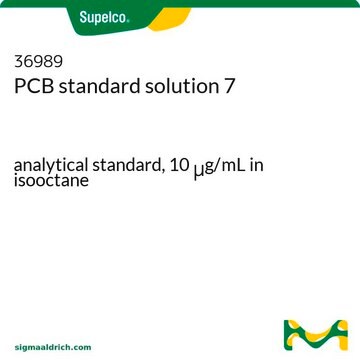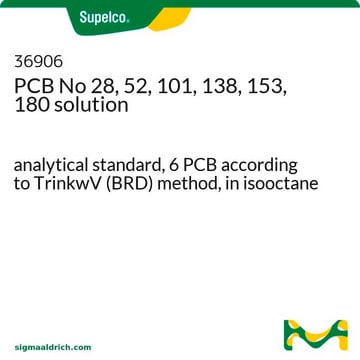35592
PCB No 2
analytical standard
Synonym(s):
3-Chlorobiphenyl, 3-PCB
Sign Into View Organizational & Contract Pricing
All Photos(1)
About This Item
Empirical Formula (Hill Notation):
C12H9Cl
CAS Number:
Molecular Weight:
188.65
Beilstein:
1863135
Ballschmiter Number:
2
EC Number:
MDL number:
UNSPSC Code:
41116107
PubChem Substance ID:
NACRES:
NA.24
Recommended Products
grade
analytical standard
Quality Level
shelf life
limited shelf life, expiry date on the label
technique(s)
HPLC: suitable
gas chromatography (GC): suitable
application(s)
environmental
format
neat
SMILES string
Clc1cccc(c1)-c2ccccc2
InChI
1S/C12H9Cl/c13-12-8-4-7-11(9-12)10-5-2-1-3-6-10/h1-9H
InChI key
NMWSKOLWZZWHPL-UHFFFAOYSA-N
Looking for similar products? Visit Product Comparison Guide
General description
Polychlorinated biphenyls (PCBs) are groups of chemical compounds which are persistent in the environment and are considered highly toxic to humans and animals. PCB No 2 may be used for environmental analysis and precise quality control of food and feed.
Application
Refer to the product′s Certificate of Analysis for more information on a suitable instrument technique. Contact Technical Service for further support.
Recommended products
Find a digital Reference Material for this product available on our online platform ChemisTwin® for NMR. You can use this digital equivalent on ChemisTwin® for your sample identity confirmation and compound quantification (with digital external standard). An NMR spectrum of this substance can be viewed and an online comparison against your sample can be performed with a few mouseclicks. Learn more here and start your free trial.
Signal Word
Warning
Hazard Statements
Precautionary Statements
Hazard Classifications
Aquatic Acute 1 - Aquatic Chronic 1 - STOT RE 2
Storage Class Code
11 - Combustible Solids
WGK
WGK 3
Flash Point(F)
Not applicable
Flash Point(C)
Not applicable
Personal Protective Equipment
dust mask type N95 (US), Eyeshields, Gloves
Choose from one of the most recent versions:
Already Own This Product?
Find documentation for the products that you have recently purchased in the Document Library.
Mirta L Menone et al.
Chemosphere, 60(1), 79-84 (2005-05-25)
Organic contaminants of environmental concern such as polychlorinated biphenyls have dispersed widely throughout the ecosystems and accumulate in living organisms, and a variety of adverse biological effects have been reported. In this study, we investigated the effects of 3-chlorobiphenyl in
D Springael et al.
Microbiology (Reading, England), 142 ( Pt 11), 3283-3293 (1996-11-01)
Chromosomal DNA fragments encoding the ability to utilize biphenyl as sole carbon source (Bph+) were mobilized by means of plasmid RP4::Mu3A from strain JB1 (tentatively identified as Burkholderia sp.) to Alcaligenes eutrophus CH34 at a frequency of 10(-3) per transferred
R R Fulthorpe et al.
Applied and environmental microbiology, 58(1), 314-325 (1992-01-01)
A chlorobenzoate-catabolic transposon (Tn5271) was introduced on a conjugative plasmid (pBRC60) in the natural host, Alcaligenes sp. strain BR60, into lake water and sediment flowthrough microcosms. Experimental microcosms were exposed to micromolar levels of 3-chlorobenzoate, 4-chloroaniline, 2,4-dichlorophenoxyacetate, or 3-chlorobiphenyl. The
Andrew C Singer et al.
Journal of microbiological methods, 60(3), 417-422 (2005-01-15)
Raman confocal microscopy was used to discriminate between cultures of Burkholderia xenovorans LB400 exposed to four different common environmental pollutants: phenanthrene, dodecane, 3-chlorobiphenyl and pentachlorophenol. Evidence is presented for the application of Raman spectroscopy as a bioassay for pollutant bioavailability
B P Maliwal et al.
Journal of lipid research, 23(3), 474-479 (1982-03-01)
The uptake, distribution, and exchange of chlorinated hydrocarbon insecticides (dieldrin and chlordecone) and biphenyls (2,4,5-2',4',5'-hexachlorobiphenyl and 3-chlorobiphenyl) among human lipoproteins was examined by fluorescence quenching, gel filtration, and ultrafiltration. The chlorinated hydrocarbons were rapidly taken up from solution or silica
Our team of scientists has experience in all areas of research including Life Science, Material Science, Chemical Synthesis, Chromatography, Analytical and many others.
Contact Technical Service










